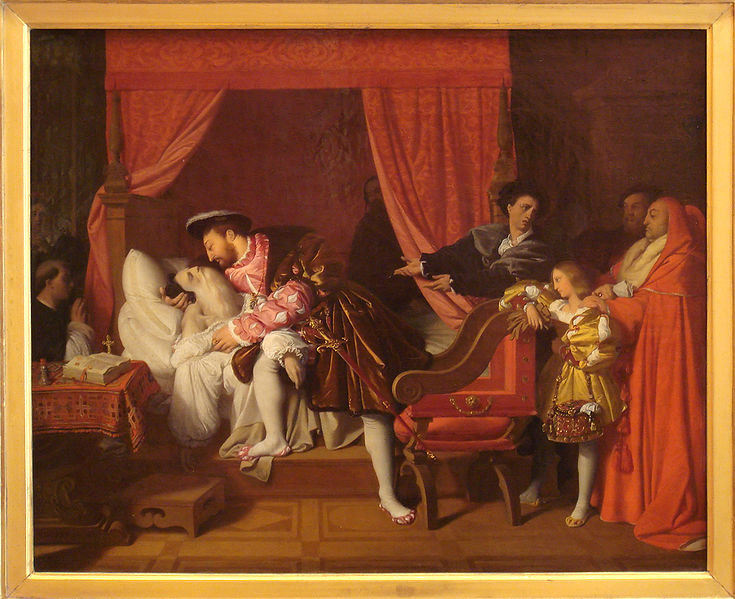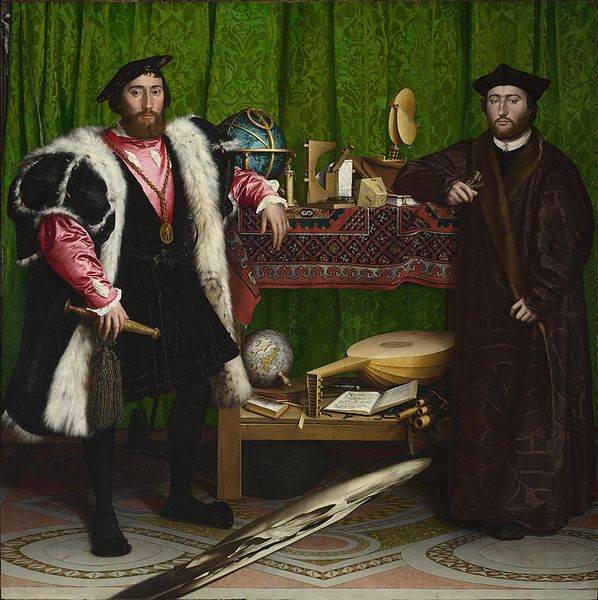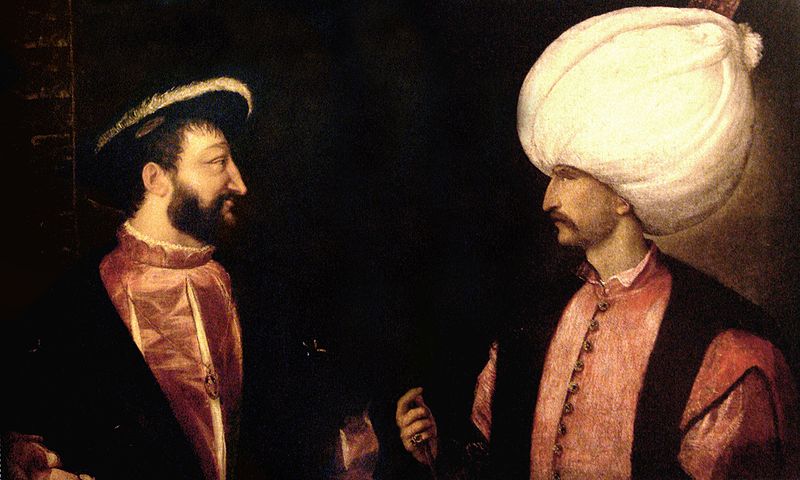<Back to Index>
- Explorer Henry Hudson, 1560/70s
- Painter Anselm Feuerbach, 1829
- King of France Francis I, 1494
PAGE SPONSOR
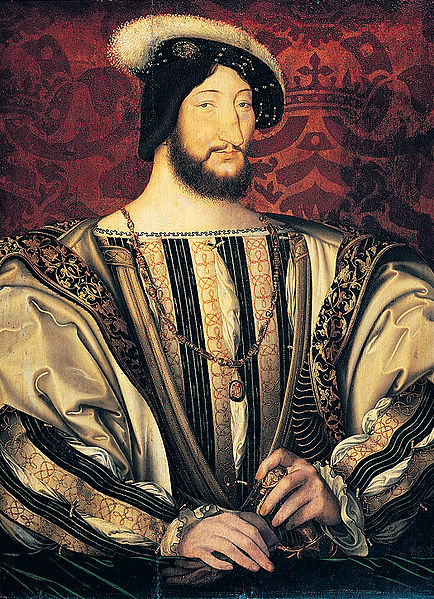
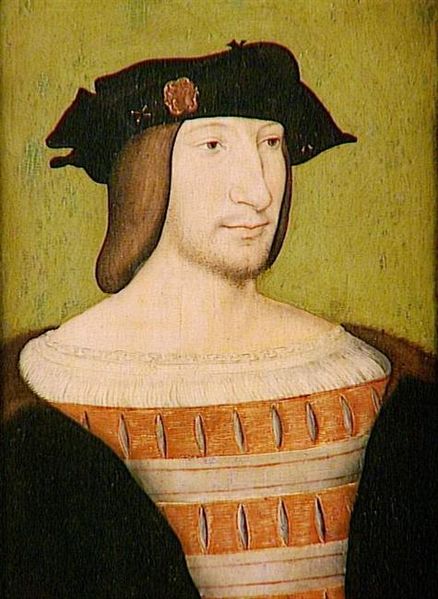
Francis I (French: François Ier) (12 September 1494 – 31 March 1547) was King of France from 1515 until his death.
Francis I is considered to be France's first Renaissance monarch. His reign saw France make immense cultural advances. He was a contemporary of Suleiman the Magnificent of the Ottoman Empire, with whom he was allied in a Franco-Ottoman alliance, as well as of Henry VIII of England and of Holy Roman Emperor Charles V, his great rivals. Francis I, the only son of Charles, Count of Angoulême, and of Louise of Savoy, was born at the Château de Cognac, Cognac (c. 400 km southwest of Paris), in the modern French department of Charente, in the province of Saintonge which was part of the former Duchy of Aquitaine. His father was the first cousin of King Louis XII. In 1498, the four year old Francis, already Count of Angoulême, was created Duke of Valois. He was the heir presumptive of Louis XII who did not succeed in siring sons with any of his three wives. In 1506, and by instigation of Louis XII, young Francis was betrothed to his own second cousin Claude of France, the daughter of Louis XII and Anne of Brittany, and heiress of the Duchy of Brittany. The marriage took place on 18 May 1514. Because of the Salic Law that excluded women from succeeding to the throne of France, the throne passed to Francis I at the death of Louis XII of France, as he was a male-line great-great-grandson of Charles V of France and the descendant of the eldest surviving male line of the Capetian Dynasty. Claude, Duchess of Brittany, became queen consort of France. In 1515 Francis was crowned King of France in the Cathedral of Reims. Despite being only twenty years old, he already had unprecedented humanist credentials. While his two predecessors, Charles VIII and
Louis XII, had spent much of their reigns concerned with Italy they did
not much embrace the new intellectual movements coming out of it. Both
monarchs continued in the same patterns of behavior that had dominated
the French monarchy for centuries. They are considered the last of the
medieval French monarchs, but they did lay the groundwork for the Renaissance to come into full swing in France. Contact
between the French and Italians in the long running series of wars
under Charles VIII and Louis XII had brought new ideas to France by the
time the young Francis was receiving his education. Thus a number of
his tutors, such as Desmoulins, his Latin instructor, and Christophe de Longueil were
schooled in the new ways of thinking and they attempted to imbue
Francis with it. Francis' mother also had a great interest in Renaissance art,
which she passed down to her son. One certainly cannot say that Francis
received a humanist education; most of his teachers had not yet been
affected by the Renaissance. One can, however, state that he clearly received an education more oriented towards humanism than any previous French king. By the time Francis ascended the throne in 1515, the Renaissance had
clearly arrived in France, and Francis was an important supporter of
the change. He became a major patron of the arts and lent his support
to many of the greatest artists of his time and encouraged them to come
to France. Some did work for him, including such greats as Andrea del Sarto, and Leonardo da Vinci,
whom Francis convinced to leave Italy in the last part of his life.
While Leonardo did little painting in his years in France, he brought
with him many of his great works, such as the Mona Lisa, known in France as La Joconde, and these stayed in France upon his death. Other major artists, whom Francis employed, include the goldsmith Benvenuto Cellini, and the painters Rosso, Romano and Primaticcio,
all of whom were heavily employed in decorating Francis' various
palaces and exceedingly loyal. Francis employed a number of agents in
Italy who endeavoured to procure artworks by Italian masters such as Michelangelo, Titian, and Raphael and ship them to France. These agents had some notable successes, even if plans to try to move Leonardo's Last Supper to
France proved impractical. When Francis ascended the throne, the royal
palaces were decorated with only a scattering of great paintings, and
not a single piece of sculpture either ancient or modern. It is during
Francis' reign that the magnificent art collection of the French kings
that can still be seen in the Louvre was truly begun. Francis was also renowned as a man of letters. When Francis comes up in a conversation among characters in Castiglione's Book of the Courtier, it is as the great hope to bring culture to the war-obsessed French
nation. Not only did Francis support a number of major writers of the
period, he was a poet himself, if not one of immense quality. Francis
worked hard at improving the royal library. He appointed the great French humanist Guillaume Budé as
chief librarian, and began to expand the collection. Francis employed
agents in Italy looking for rare books and manuscripts, just as he had
looking for art works. During his reign, the size of the library
increased greatly. Not only did Francis expand the library, there is
also, according to Knecht, evidence that he read the books he bought
for it, a much rarer feat in the royal annals. Francis set an important
precedent by opening his library to scholars from around the world in
order to facilitate the diffusion of knowledge. In 1537, Francis signed the Ordonnance de Montpellier, decreeing that his library be given a copy of every book to be sold in France. Francis's older sister, Marguerite, Queen of Navarre, was also an accomplished writer, producing the classic, Heptameron. Francis poured vast amounts of money into new structures. He continued the work of his predecessors on the Château d'Amboise and also started renovations on the Château de Blois. Early in his reign, he also began construction of the magnificent Château de Chambord, inspired by the styles of the Italian renaissance, and perhaps even designed by Leonardo da Vinci. Francis rebuilt the Louvre, transforming it from a medieval fortress into a building of Renaissance splendour. He financed the building of a new City Hall (Hôtel de Ville) for Paris in order to have control over the building's design. He constructed the Château de Madrid in the Bois de Boulogne, and rebuilt the Château de St-Germain-en-Laye. The largest of Francis' building projects was the reconstruction and expansion of the royal château of Fontainebleau, which quickly became his favourite place of residence, as well as the residence of his official mistress - Anne, duchess of Étampes. Each of Francis' projects was luxuriously decorated both inside and
outside. Fontainebleau, for instance, had a gushing fountain in its
courtyard where quantities of wine were mixed with the water.
Militarily and politically, Francis's reign was less successful; he tried and failed to become Holy Roman Emperor, and pursued a series of wars in Italy. Francis managed to defeat the Swiss at Marignano in 1515, which enabled him to capture the Italian city-state of Milan. Much of the military activity of Francis's reign was focused on his sworn enemy, the Holy Roman Emperor Charles V.
Francis and Charles had an intense personal rivalry and a bitter hatred
for one another, which they inherited from their predecessors' wars in
Burgundy and Orleans; Charles, in fact, brashly challenged Francis
himself to single combat, multiple times. In addition to the Holy Roman
Empire, Charles personally ruled Spain, Austria and a number of smaller possessions neighboring France, and was thus a threat to Francis's kingdom. Francis attempted to arrange an alliance with Henry VIII of England with negotiations taking place at the famous Field of Cloth of Gold on 7 June 1520 but, despite a lavish fortnight of diplomacy, they ultimately failed to reach agreement.
Francis' most devastating defeat occurred at the Battle of Pavia (24 February 1525), where he was captured by Charles: Cesare Hercolani hurt his horse and Francis was captured by Spaniards Juan de Urbieta, Diego Dávila and Alonso Pita. For this reason, Hercolani was named "victor of the battle of Pavia". The famous Zuppa alla Pavese, now a renowned recipe, was said to have been invented on the spot to feed the captive king right after the battle. Francis was held captive in Madrid. In the Treaty of Madrid signed
on 14 January 1526, Francis I was forced to make major concessions to
Charles V before he was freed on 17 March 1526. Francis was allowed to
return to France in exchange for his two sons, Francis and Henry, but once he was free he argued that his agreement with Charles was made under duress,
and also claimed that the agreement was void, as his sons had been
taken hostage suggesting his word alone was not trusted, and he
repudiated it. Francis
continued to persevere in his hatred of Charles V and desire to control
Italy via more wars in Italy. The repudiation of the Treaty of Madrid led to the War of the League of Cognac. After the failure of the league, he obtained the help of the Ottoman Empire and went to war again in Italy in the Italian War of 1536 – 1538 after the death of Francesco II Sforza,
the ruler of Milan. He was defeated once again by Charles V and forced
to sign the Treaty of Nice. However, the Treaty of Nice collapsed and
led to the Francis' final attempt on Italy in the Italian War of 1542 – 1546. This time, Francis managed to hold off the forces of Charles V and England's Henry VIII and Charles V was forced to sign the Treaty of Crepy because of financial problems and problems with the Schmalkaldic League. In order to counter-balance the power of the Habsburg Empire under Charles V, Holy Roman Emperor, and especially its control of large parts of the New World through the Crown of Spain, Francis I endeavoured to develop contacts with the New World and Asia. Fleets were sent to the Americas and the Far East, and close contacts were developed with the Ottoman Empire, that would permit the development of French Mediterranean trade as well as the establishment of a strategic military alliance. The port city now known as Le Havre was
founded in 1517, in Francis I's early years on the throne. Founding a
new port was urgently needed in order to replace the ancient harbours of Honfleur and Harfleur whose utility had decreased due to silting. Le Havre was originally named Franciscopolis after the King who founded it, but this name did not survive later reigns. In 1524, Francis assisted the citizens of Lyon in financing the expedition of Giovanni da Verrazzano to North America; on this expedition, Verrazzano claimed Newfoundland for the French crown and founded New Angoulême on the actual site of New York City. In 1531, Bertrand d'Ornesan, Baron de Saint-Blancard, tried to establish a French trading post at Pernambuco, Brazil. In 1534, Francis sent Jacques Cartier to explore the St. Lawrence River in Quebec to find certaines îles et pays où l'on dit qu'il se doit trouver grande quantité d'or et autres riches choses ("certain islands and lands where it is said there must be great quantities of gold and other riches"). In 1541, Francis sent Jean-François de la Roque de Roberval to settle Canada and to provide for the spread of "the Holy Catholic faith."
French trade with East Asia was initiated during the reign of Francis I with the help of shipowner Jean Ango. In July 1527, a French Norman trading ship from the city of Rouen is recorded by the Portuguese João de Barrosto have arrived in the Indian city of Diu. In 1529, Jean Parmentier of Dieppe, onboard the Sacre and the Pensée, reached Sumatra. Upon its return, the expedition triggered the development of the Dieppe maps, influencing the work of Dieppe cartographers, such as Jean Rotz. Under the reign of Francis I, France became the first country in Europe to establish formal relations with the Ottoman Empire, and to set up instruction in the Arabic language, through the instruction of Guillaume Postel at the Collège de France. In a watershed moment in European diplomacy, Francis came to an understanding with the Ottoman Empire, which transformed into a Franco-Ottoman alliance.
The alliance has been called "the first nonideological diplomatic
alliance of its kind between a Christian and non-Christian empire". It did however cause quite a scandal in the Christian world, and was designated as "the impious alliance", or "the sacrilegious union of the Lily and the Crescent"; nevertheless, it endured since it served the objective interests of both parties. The two powers colluded against Charles V, and, in 1543, they even combined for a joint naval assault in the Siege of Nice. In 1533, Francis I sent as ambassador to Morocco, colonel Pierre de Piton, initiating official France-Morocco relations. In a letter to Francis I dated August 13, 1533, the Wattassid ruler of Fez, Ahmed ben Mohammed, welcomed French overtures and granted freedom of shipping and protection of French traders. Francis I took several steps to eradicate the monopoly of Latin as the language of knowledge. In 1530, he declared French the national language of the kingdom, and that same year opened the Collège des trois langues, or Collège Royal, following the recommendation of humanist Guillaume Budé, in which were taught Greek, Hebrew and Chaldean, and from 1539 Arabic under Guillaume Postel. In 1539, in his castle in Villers-Cotterêts, Francis signed the important edict known as Ordinance of Villers-Cotterêts, which, among other reforms, made French the administrative language of the kingdom, replacing Latin.
This same edict required priests to register births, marriages and
deaths and to establish a registry office in every parish. This
established the first records of vital statistics with filiations
available in Europe. It was during Francis' reign that divisions in the Christian religion in Western Europe erupted. Martin Luther's preaching and writing led to the formation of the Protestant movement which spread through much of Europe, including France. Initially,
under the influence of his beloved sister Marguerite de Navarre,
Francis was relatively tolerant of the new movement, and even
considered it politically useful, as it caused many German princes to
turn against his enemy, Charles V. However, Francis' attitude toward
Protestantism changed following the "Affair of the Placards", on the night of 17 October 1534, in which notices appeared on the streets of Paris and other major cities denouncing Mass. A notice was even posted on the door to the king's room, and, it is said, the box in which he kept his handkerchief. Antoine Marcourt, a Protestant pastor, was responsible for the notices.
The
most fervent Catholics were outraged by the notice's allegations.
Francis himself came to view the movement as a plot against him, and
began to persecute its followers. Protestants were jailed and executed.
In some areas whole villages were destroyed. Printing was censored and leading Protestants like John Calvin were forced into exile. The persecutions soon numbered tens of thousands of homeless people. These persecutions against Protestants were codified in the Edict of Fontainebleau (1540) issued by Francis. Major persecutions continued, as when Francis I ordered the massacre of the Waldensians at the Massacre of Mérindol in 1545. Francis died at the château de Rambouillet on
31 March 1547, on his son and heir's 28th birthday. It is said that "he
died complaining about the weight of a crown that he had first
perceived as a gift from God". Francis I was interred with his first wife, Claude de France, Duchess of Bretagne, in Saint Denis Basilica. He was succeeded by his son, Henry II. Francis'
tomb, that of his wife and of his mother, along with the tombs of other
French kings and members of the royal family, were desecrated on 20
October 1793, during the Reign of Terror, at the height of the French Revolution. Francis'
legacy is generally considered a mixed one. He achieved great cultural
feats, but they came at the expense of France's economic well-being. The persecution of the Protestants was to lead France into decades of civil war, which did not end until 1598 with the Edict of Nantes.
